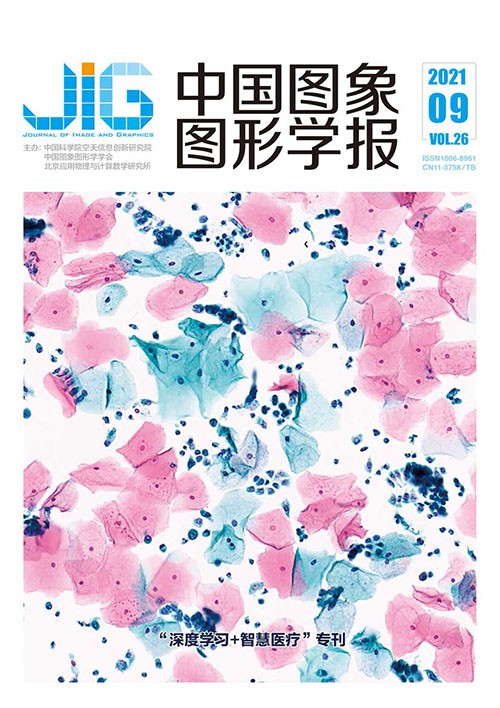
肺部影像解剖结构分割数据集及应用
摘 要
目的 从影像中快速精准地分割出肺部解剖结构可以清晰直观地分辨各解剖结构间的关系,提供有效、客观的辅助诊断信息,大大提高医生的阅片效率并降低医生的工作量。随着影像分割算法的发展,越来越多的方法应用于分割肺部影像中感兴趣的解剖结构区域,但目前尚缺乏包含多种肺部精细解剖结构的影像数据集。本文创建了一个带标签的肺部CT/CTA (computer tomography/computer tomography angiography)影像数据集,以促进肺部解剖结构分割算法的发展。方法 该数据集共标记了67组肺部CT/CTA影像,包括CT影像24组、CTA影像43组,共计切片图像26 157幅。每组CT/CTA有4个不同的目标区域类别,标记对应支气管、肺实质、肺叶、肺动脉和肺静脉。结果 本文利用该数据集,用于肺部CT解剖结构分割医学影像挑战赛——2020年第四届国际图像计算与数字医学研讨会,该挑战赛提供了一个肺血管、支气管和肺实质的评估平台,通过Dice系数、过分割率、欠分割率、医学和算法行业专家对分割和3维重建效果进行了评估,目的是比较各种算法分割肺部解剖结构的性能。结论 本文详细描述了包括支气管、肺实质、肺叶、肺动脉和肺静脉等解剖结构标签的肺部影像数据集和应用结果,为相关研究人员利用本数据集进行更深入的研究提供参考。
关键词
Pulmonary image anatomical structure segmentation dataset and applications
Tan Wenjun1,2, Li Xiaoshuo2, Zhou Qinghua2, Liu Pan2, Yang Jinzhu1,2(1.Key Laboratory of Intelligent Computing in Medical Image, Ministry of Education, Northeastern University, Shenyang 110169, China;2.School of Computer Science and Engineering, Northeastern University, Shenyang 110169, China) Abstract
Objective Images-based segmentation of pulmonary anatomy has been set up the anatomical structures to formulate rapid and targeted diagnostic information. The purpose of pulmonary anatomy segmentation has been associated to a pixel in an image with an anatomical structure without the need for manual initialization. A lots of supervised deep learning image segmentation have been illustrated for segmenting regions of interest in pulmonary CT(computer tomography) images. The medical image segmentation has greatly relied on high-quality labeled medical image data, CT images-based lung anatomy labeled data has been insufficient adopted due to the lack of expert annotation of regions of interest and the lack of infrastructure and standards for sharing labeled data. Most of pulmonary CT annotation datasets have focused on thoracic cancer, pulmonary nodules, tuberculosis, pneumonia and lung segmentation. A dataset of pulmonary CT/CTA(computer tomography/computer tomography angiography) scan images with labels has facilitated the evolvement of pulmonary anatomical structure segmentation algorithms. The dataset has been evaluated the performance of state-of-the-art pulmonary anatomy structure segmentation methods for chest CT scans. It has been difficult to compare various algorithms for pulmonary anatomy structure segmentation. Different methods have been evaluated on different datasets using different evaluation measures in common. The related dataset has implemented a dataset of chest CT scans to identify varying abnormalities based on the reference standards in the context of airway, lung parenchyma, lobe and pulmonary artery. The vein segmentations have been established. The dataset has a unique calculation to compare pulmonary anatomy structure algorithms via the comparison all methods against the reference standard baseline. Method A sum of 67 sets of CT/CTA images of the pulmonary have labeled in this dataset including 24 sets of CT images and 43 sets of CTA images via a total of 26 157 slices images. Each set of CT/CTA images have labeled for airway, lung parenchyma, lobe, pulmonary artery and vein. Multi-channel images have represented a variety of regular-based clinical scanners based on a reconstructed mediastinal window algorithm. The medical image-based dataset has been annotated and verified via. Manual corrections have annotated using internal software funded by the Key Laboratory of Medical Imaging Intelligent Computing, Ministry of Education. Result Part of dataset representative segmentation tasks have been used via pulmonary CT anatomical structure segmentation (conference details:the medical image challenge competition held during the 4th International Symposium on Image Computing and Digital Medicine (ISICDM) in Shenyang, China). The representative dataset has included 10 groups of CT and CTA in the training dataset and 5 groups of test dataset. The challenge competition has also offered a platform for evaluating model performance of pulmonary blood vessels, airways and lung parenchyma. The result of segmentation and the effect of 3D reconstruction have evaluated by Dice coefficients, over-segmentation rate, under-segmentation rate and medical and algorithmic industry experts. Conclusion Four parts of labeled image datasets have been used as a pulmonary CT dataset. This dataset has labeled using different colored pixels and saved respectively for different pulmonary anatomies structure. The annotated data have been re-formatted to ensure easy access. The location of the markers in color pixels has been displayed via 25 000 labeled sliced images dataset using the image format of the raw data. All annotated images from the digital imaging and communications in medicine (DICOM) format to portable network graphics (PNG) images has been converted based on standard DICOM data. The chest CT image dataset has provided valid annotated data via DICOM-based sensitive information re-movement. First each set of CT/CTA has labeled with 4 different target region categories in the context of airway, lung parenchyma, lobe and pulmonary artery and vein to complement the anatomical structure of CT/CTA image dataset of the pulmonary. Next, a partially representative dataset has been and the have verified by the challenge competition. Lastly, clear and intuitive 3-dimensional visualized structural images have been reconstructed for the acquisition of each anatomical structure of the pulmonary segmented via CT/CTA images to assist in the diagnosis of pulmonary diseases. First, this dataset has not annotated lung segments. It has been difficult to obtain that the invisibility of lung segment boundaries based on targeted and accurate reference segmentation criteria. Second, the annotation data have been basically carried out on healthy images and rarely on lesion images. The most important feature of medical datasets has upgraded the diversity of data. The robustness of image segmentation have been implementing further. Last, manual annotation of medical anatomical structure images have inevitably resulted some errors. Supplementing lung segments markers and improving the diversity of data based on pulmonary CT anatomical structure segmentation algorithms have been implementing further via labeling more lesion images.
Keywords
pulmonary anatomical structure pulmonary computed tomography image dataset segmentation of images medical imaging
|



 中国图象图形学报 │ 京ICP备05080539号-4 │ 本系统由
中国图象图形学报 │ 京ICP备05080539号-4 │ 本系统由